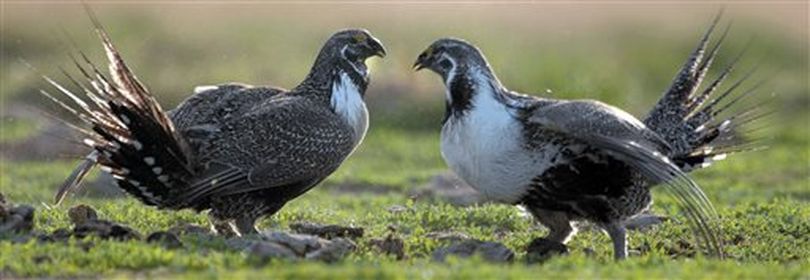Feds reject endangered status for sage grouse; give reins to states, ranchers

THREATENED SPECIES -- The U.S. Fish and Wildlife Service has determined after a four year-study that the greater sage-grouse does not warrant protection under the Endangered Species Act as long as states and ranchers work to improve the plight of the bird on 60 million acres of sagebrush lands across 11 western states.
The U.S. Fish and Wildlife Service’s decision to give state and federal conservation efforts an opportunity to save the sage grouse and its habitat offers a reprieve from stifling restrictions that could have been inflicted on ranchers and local economies that depend on this Western landscape.
Interior Secretary Sally Jewell made the announcement today backed by state governors at the Rocky Mountain Arsenal National Wildlife Refuge near Denver. Federal officials say the greater sage grouse won’t need the protections of the Endangered Species Act because of the safeguards in state and federal conservation plans and work by private landowners.
“What’s good for the bird is good for the herd—and today’s decision will help rebuild greater sage grouse populations and conserve sagebrush habitat that supports more than 300 species, including pronghorn, mule deer, and elk, says Collin O’Mara, president and CEO of the National Wildlife Federation. "This decision illustrates what the Endangered Species Act is supposed to be all about: galvanizing collaborative efforts to save wildlife species before they’re on the brink of extinction.”
The National Wildlife Federation and many sportsmen and conservation groups are on board with the decision. The NWF points out that it follows years of work by private landowners, ranchers, sportsmen, conservationists, industry, and state and federal agencies "to develop achievable conservation plans based upon science, which, when implemented with sufficient resources and adjusted as needed, provide a blueprint for sustaining healthy wildlife populations and habitats across the West."
Jamie Rappaport Clark, Defenders of Wildlife president and former head of the U.S. Fish and Wildlife Service is a step down in enthusiasm for the terms of the decision:
“We commend the administration’s unprecedented and epic land use planning process covering millions of acres of public lands throughout the American West, but the final plans fall short of what is necessary to eliminate known threats to the greater sage-grouse. While the final federal sage-grouse plans advance wildlife management on millions of acres of public lands, they failed to adopt key conservation measures identified by the government’s own scientists and sage-grouse experts as critical to conserving the bird, such as protecting winter habitat or confronting the growing threat of climate change to the species’ habitat."
But Eric Holst of the Environmental Defense Fund, is singing praises to the decision and the process that led to it:
- “Today’s ‘not warranted’ decision sends a strong signal that investments in conservation are making a difference and provide the catalyst for a different kind of politics.”
- "New solutions like the Colorado Habitat Exchange prove that wildlife conservation does not have to come at the expense of the economy. That in fact, it is just the opposite.”
- “The greater sage-grouse was not put on the Endangered Species Act today because of major investments made in private working lands, and strong commitments by ranchers to steward their lands for sage-grouse.”
Sportsmen’s groups, including Pheasants Forever, are encouraged by the decision and appreciative of the 11 states, federal agencies, private landowners, and other vested stakeholders that have come together in a daunting, often controversial effort.
“The work to benefit sage grouse over the last five years has been the greatest landscape-scale conservation effort undertaken in modern times,” says Steve Williams, president of the Wildlife Management Institute and former director of the U.S. Fish and Wildlife Service. “The collaboration we’ve seen is unprecedented and extraordinary. It sets forth a model for what I believe to be the future of conservation in America.”
While many conservation groups applauded the effort, some also are pointing out that monitoring for accountability will be required.
"We are concerned about continued habitat loss from oil and gas drilling and new power line construction,” said Steve Holmer, Senior Policy Advisor for American Bird Conservancy. “We want to see regular reviews of the species’ population trend to learn if the current long-term decline is reversed. The plans must be shown to be working, and the extraordinary conservation efforts on private lands continued. If not, the listing issue may have to be revisited in the future.”
Utah politicians are taking a different view:
Utah governor, congressman disagree with federal sage grouse decision
While the governors of Montana, Colorado and Wyoming joined Interior Secretary Sally Jewell today in Colorado for the announcement that the sage grouse will not be listed for protection under the Endangered Species Act, Utah Gov. Gary Herbert was not on board, and said he would seek relief from both Congress and the courts. Also, U.S. Rep. Rob Bishop called the decision a "de facto listing."
Salt Lake Tribune
Idaho Gov. Butch Otter's take on sage grouse decision: "Unfortunately, this is far from over," reports the S-R's Betsy Russell in Boise.
Secretary Jewell made the announcement with a video that explains why the sage grouse decision is historic and sets the groundwork for a 21st-century approach to conservation:
